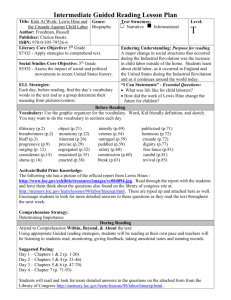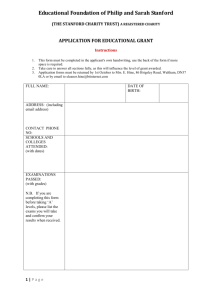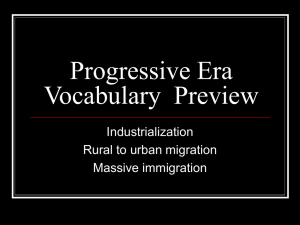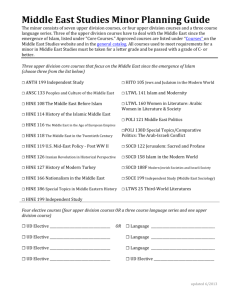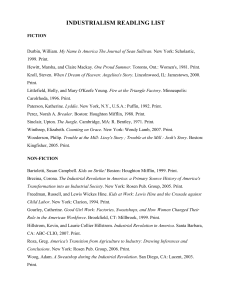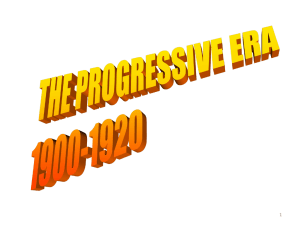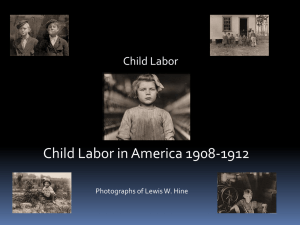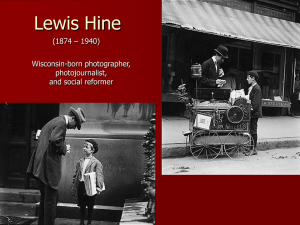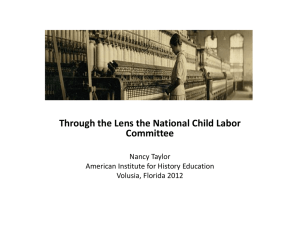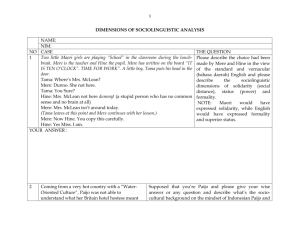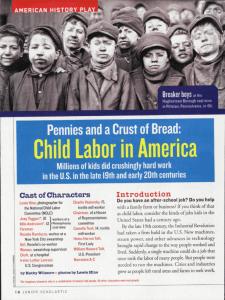A SOCIAL CONSCIENCE The famous author Charles Dickens
advertisement
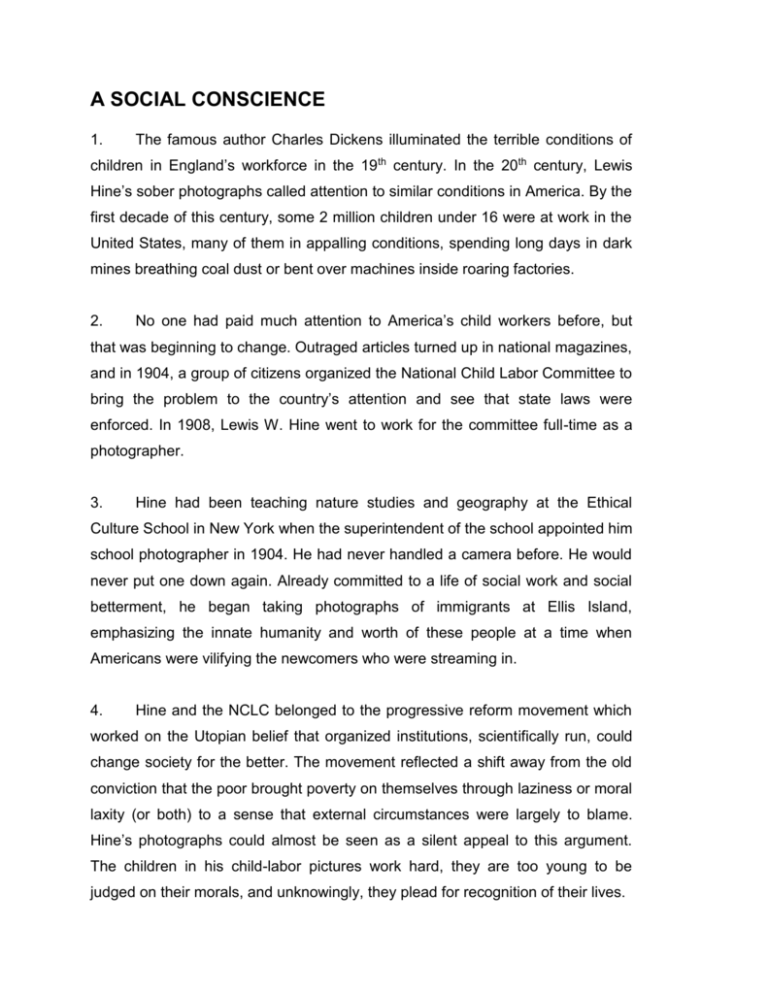
A SOCIAL CONSCIENCE 1. The famous author Charles Dickens illuminated the terrible conditions of children in England’s workforce in the 19th century. In the 20th century, Lewis Hine’s sober photographs called attention to similar conditions in America. By the first decade of this century, some 2 million children under 16 were at work in the United States, many of them in appalling conditions, spending long days in dark mines breathing coal dust or bent over machines inside roaring factories. 2. No one had paid much attention to America’s child workers before, but that was beginning to change. Outraged articles turned up in national magazines, and in 1904, a group of citizens organized the National Child Labor Committee to bring the problem to the country’s attention and see that state laws were enforced. In 1908, Lewis W. Hine went to work for the committee full-time as a photographer. 3. Hine had been teaching nature studies and geography at the Ethical Culture School in New York when the superintendent of the school appointed him school photographer in 1904. He had never handled a camera before. He would never put one down again. Already committed to a life of social work and social betterment, he began taking photographs of immigrants at Ellis Island, emphasizing the innate humanity and worth of these people at a time when Americans were vilifying the newcomers who were streaming in. 4. Hine and the NCLC belonged to the progressive reform movement which worked on the Utopian belief that organized institutions, scientifically run, could change society for the better. The movement reflected a shift away from the old conviction that the poor brought poverty on themselves through laziness or moral laxity (or both) to a sense that external circumstances were largely to blame. Hine’s photographs could almost be seen as a silent appeal to this argument. The children in his child-labor pictures work hard, they are too young to be judged on their morals, and unknowingly, they plead for recognition of their lives. 5. The idea that photography could assist in social reform was as new as highly organized reform itself. For a half-century after the invention of the medium, photographers had portrayed the poor as picturesque creatures; it was not considered polite to air society’s dirty linen. Jacob Riis, a crusading journalist, learned how to photograph in order to add irrefutable proof to his reports on the slums. With his 1890 book, How the Other Half Lives, he introduced a shocked audience to the squalid life in New York tenements. Some of tenements were subsequently torn down, largely because of Riis’s work. 6. The NCLC was both committed to publicizing its cause and expert at doing so. Hine soon proved his own expertise. In fact, his major contribution lies not in his pictures alone but in the new uses he made of them and the new ways he devised to get them before people’s eyes. His photographs were essential to the committee’s success. Though the federal government did not ban child labor until 1938, the NCLC did sway public opinion and helped persuade Washington to set up the U.S. Children’s Bureau to oversee children’s welfare in 1912. In 1947, the NCLC chairman credited Hine with bringing the need for labor reform to the public’s attention: “The evils were intellectually but not emotionally recognized until his skill, vision and artistic finesse focused the camera intelligently on these social problems.” 7. Whenever possible, Hine’s images insist on communication with the subject: the children look straight ahead, engaging their viewer directly. They not only know the photographer is there, but trust him; sometimes, incongruously, they smile, despite oppressive machines, bare feet, and demeaning work. (Cameras demand smiles even from the unhappy.) 8. Since Hine usually carried about 50 pounds of equipment, including a stand camera, a tripod and a flash tray, his subjects could not avoid knowing he was there. But sometimes he had to work too fast for posing. In the South, where a high proportion of workers were underage, the mill owners argued that child labor kept families alive, and they weren’t eager to have that position debunked. Factory owners elsewhere believed that the situation was fine the way it was, denied it existed, or refused to let a stranger in for fear of exposure 9. Hine resorted to ruses where he had to. He claimed to be an industrial photographer, a Bible salesman, or the representative of a postcard company. Inside he made notes with one hand in his pocket and estimated the children’s height by marking down which button on his jacket they came up to. The dark and claustrophobic interior pictures were especially convincing in an era when people believed that fresh air was vital to good health and had recently began building playgrounds for city children. 10. When all else failed, Hine waited at entrances and exits for the youngsters to come by. There they stand, in the middle of most of Hine’s pictures; there is absolutely no mistaking the focus of attention. The girl in the mill is positioned so that her head is at the precise vanishing point of the machine’s perspective lines, as if the machines themselves were concentrated on her, perhaps intent on crushing her. Oddly, a man’s face stares out from the side; no sense on his part that anything is wrong. 11. The children stand at middle distance because that is what Hine’s equipment allowed. The wide spaces on either side of them provide the context that his notes would fill in – even if that context is merely emptiness and isolation, as in the picture of the one-legged newsboy, 8 years old, who earns one or two dollars a day. 12. Hine always tried to produce a witness to his photography (sometimes his wife). Many people simply did not believe children were at work in such large numbers and such vile conditions; his data had to be entirely credible. In 1910 he wrote to a friend, “My child-labor photos have already set the authorities to work to see if such things can be possible. They try to get around them by crying ‘fake’, but therein lies the value of the date and a witness.” 13. Without being too sentimental, he found details that summed up strain and poverty: the broken suspender of a young mill worker, the bare feet of an oyster shucker on a mountain of shells, the resigned posture of a glass worker. Most of the children he photographed are survivors – resilient, even tough, and dignified in their way. That was part of his message, part of his belief about humanity. But he did not hesitate to show his subjects smoking cigars and cigarettes and playing pool. Child labor was not exactly the optimum preparation for a good life in society. 14. Hines was, essentially, a propagandist, trying to make Americans rethink a situation and their obligation to it. He once said in a speech to social workers, “I wonder, sometimes, what an enterprising manufacturer would do if his goods, instead of being inanimate things, were the problems and activities of life itself, with all their possibilities of human appeal. Would he not grasp eagerly at such opportunities to play upon the sympathies of his customers as are afforded by the camera?” 15. He himself advertised for change in many and ingenious ways. He wrote captions for his pictures to double the information and impact; designed exhibitions and posters; wrote articles and illustrated them; took pictures for the NCLC’s annual report; produced photomontages, brochures and slide sets for lectures; and sequenced photographs in what were in effect the first photo essays. If all of this seems standard to us now, that is because Hine understood the power of words and photographs more fully than anyone had before, and because he tried out multiple means of communicating with a large audience and discovered that they worked. From Civilisation, January – February 1996

